Toyota
Corolla Coolant Change Guide
How to drain and refill the coolant
(antifreeze) in a 2009 to 2013 Toyota Corolla with the 2ZR-FE 1.8L I4 engine.
By Paul B. Michaels Author & Photographer Auto Mechanic Since 1989 |
||
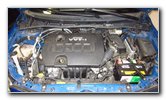 2010 Corolla 2ZR-FE |
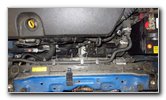 2ZR-FE Radiator & Fans |
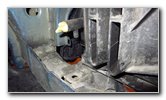 Radiator Drain Plug |
| This automotive
"how-to" guide was specifically written to assist owners of the 10th
generation (2009, 2010, 2011, 2012 and 2013) Toyota Corolla
in replacing the coolant (or "antifreeze") for the 2ZR-FE 1.8 liter
inline four cylinder engine by performing a simple drain and fill of the
radiator and overflow bottle which changes the vast majority of the old
coolant.
Performing a flush of the coolant system is NOT recommended since it will be impossible to achieve the correct ratio of 50% coolant to 50% distilled water in the cooling system. Owners of other Toyota, Lexus or Scion vehicles such as the Yaris, Matrix, Prius, 86, Camry, RAV4, Sienna, Tacoma, Tundra, FJ Cruiser, Venza, C-HR, Highlander, Avalon, Sequoia, Land Cruiser, Allion, Premio, Auris, IS 250, ES 350, GS 350, tC, xB, xD, iQ and FR-S may also find these DIY instructions to be helpful. The recommended OEM (original equipment manufacturer) coolant type is the pink colored Toyota SLLC (super long life coolant 50/50 pre-mixed) which can last up to 100,000 miles. I chose to instead buy the very popular alternative Zerex Asian Vehicle antifreeze coolant made by Valvoline which is also a pre-mixed blend of 50% coolant and 50% distilled water. The total fluid capacity of the cooling system for the 2ZR-FE 1.8L I4 engine is 5.8 U.S. quarts (5.5 liters or 4.8 Imperial quarts). Draining the radiator will only remove about 1 gallon or 4 quarts of old coolant. So you will only need to buy a one gallon bottle of new coolant. If you plan on also draining the overflow bottle, I recommend buying a second gallon of coolant. It probably takes about a quart to fill the overflow bottle to the "FULL" line. The items you'll need to complete this procedure include a used oil catch container and an automotive funnel. I would also recommend removing, flushing out and cleaning the coolant overflow tank. To detach the bottle, you'll need a 10mm socket with an extension bar and a 1/4" or 3/8" drive ratchet. Since our Corolla is 10 years old with 95,000 miles, I chose to replace the plastic drain plug (also called a drain cock or petcock), the small rubber o-ring gasket for the plug and the radiator cap. I was concerned that after thousands of heat cycles the plastic drain plug would break upon removal, the rubber o-ring on the plug would tear and the rubber gaskets on the cap would be deteriorated or rotted which could all lead to coolant leaks and possibly overheating in the future. The OEM part numbers are as follows: Drain Plug - Toyota 16417-21280, Drain Plug O-Ring - Toyota 16492-21050 and Radiator Cap - Toyota 16401-20353. The first few steps are to drive the car on to a level surface, shift the transmission into "Park" and turn off the ignition. Engage the emergency / parking brake and place wheel chocks on both sides of the rear tires to prevent the vehicle from moving.
|
||
|
|
||
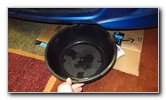 Slide Under Catch Basin |
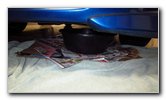 Under Drain Cock |
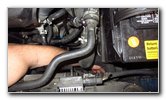 Slightly Loosen Petcock |
| Once the engine has
cooled off, look down into the engine bay on the right (driver) side of the
radiator. Locate the yellow plastic drain plug at the bottom corner of the radiator below the 12V automotive battery. Slide the used oil catch container to just below the radiator drain cock. Slowly and gently loosen the radiator drain petcock in the counterclockwise direction until a small stream of old coolant starts flowing out of the valve on the bottom of the drain tube. |
||
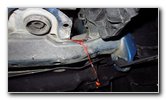 Slowly Draining Old Fluid |
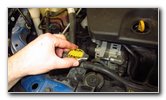 Twist Off Radiator Cap |
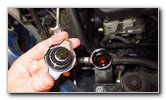 Radiator Cap Removed |
| To help the coolant
drain out more quickly, carefully twist off the radiator cap by pushing it
down and turning it 1/4 turn
in the counterclockwise direction. Do NOT remove the radiator cap if the engine is hot! Only remove the radiator cap when the engine is cold to prevent from having steam or hot coolant spray into your face or on your hands. Removing the cap will help prevent a vacuum from forming and allow the old coolant to drain out faster. Check the condition of the rubber seals on the old radiator cap. If the rubber looks damaged, rotted, torn or dried out, the cap should be replaced. The genuine OEM part number for the radiator cap is Toyota 16401-20353. Avoid buying an aftermarket radiator cap. I've read numerous stories of aftermarket radiator caps leaking. |
||
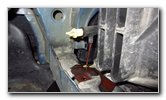 Old Coolant Draining Out |
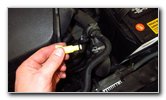 Check Old Rubber O-Ring |
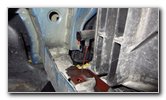 Radiator Drain Hole |
| Make sure that the
old coolant is draining out down into the catch basin. Once the flow slows down to just an occasional drop, fully remove the drain plug by twisting it out in the counterclockwise direction. This would be a good time to check the radiator hoses for any cracks, rotting or damage. If you would like to replace the thermostat as well, it is located under a plastic cover attached to a large radiator hose just below the alternator and to the right of the water pump pulley. You'll need a 10mm socket and a 1/4" or 3/8" drive ratchet to remove the two nuts that secure the thermostat housing to the front of the water pump. The OEM thermostat part number is Toyota 90916-03144 (also known as part # 9091603144). If you replace the thermostat, you will need more coolant to re-fill the cooling system since some coolant will drain out of the water pump and engine block. |
||
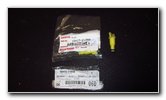 New Plastic Drain Cock |
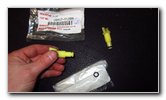 OEM Radiator Plug |
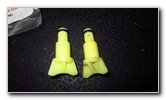 New Vs. Old Drain Plug |
| Check the condition
of the plastic drain plug and the small rubber o-ring at the tip. If the plastic looks deformed and cracked or the rubber o-ring is torn or damaged, the parts should be replaced to prevent a coolant leak. The rubber o-ring part number is Toyota 16492-21050. The plastic drain plug part number is Toyota 16417-21280. My old drain plug and its rubber o-ring appeared to be in good condition but I'm glad I purchased new parts for the extra peace of mind on long road trips. |
||
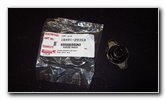 New Radiator Cap |
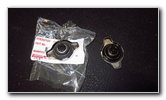 New Rubber Gaskets |
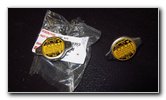 Top of New OEM Cap |
| In the row above,
you can see the old ten year old radiator cap compared to the new one. The rubber seals on the old cap did look a bit deformed and dried out. |
||
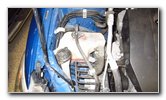 Coolant Overflow Bottle |
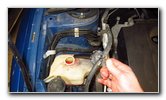 Remove Plastic Cap |
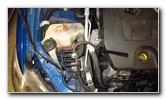 Rubber Hose Removed |
| Since I already had
about a quart of Zerex Asian Vehicle Coolant left over from a drain
and fill procedure on another Toyota, I decided to also remove the coolant overflow (A.K.A.
"recovery") bottle to clean it out. (If you only drain the radiator, you'll need about one gallon to re-fill it.) Pull off the plastic cap and remove the rubber hose from the reservoir tank. |
||
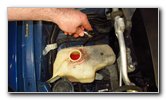 Loosen Bolts |
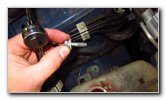 First Bolt Removed |
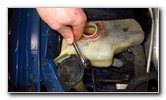 Second Bolt |
| Remove the three bolts that hold the bottle in place by turning them in the counterclockwise direction with the 10mm socket, an extension bar and a ratchet. | ||
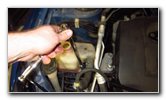 Remove 3rd Bolt |
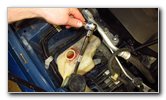 |
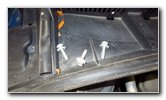 Three Bolts Removed |
| Set the three bolts aside in a safe place. | ||
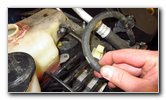 Pull Hose Off Bracket |
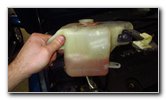 Old Coolant In Reservoir |
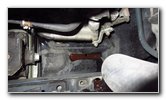 Fluid On Plastic Covers |
| Pull the rubber
hose out of the white plastic retaining clip attached to the black metal
bracket. Carefully lift the reservoir tank out of the engine bay. |
||
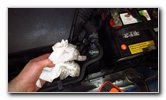 Clean Under Engine Cover |
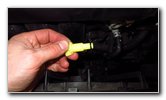 New Plug & O-Ring |
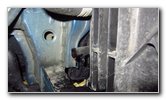 Clean Radiator Drain Hole |
| I chose to rock and
shake the front of the car a bit to make sure I got out as much old coolant
from the radiator as possible.
You could also try gently shaking and squeezing the large coolant hoses to remove a bit more coolant. Clean off any debris from the drain tube on the bottom of the radiator assembly. If you purchased a new o-ring and also a new drain plug, carefully push the new o-ring into place on the tip of the plug. |
||
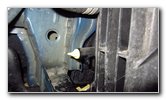 Install New Drain Plug |
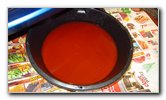 Coolant At 95,000 Miles |
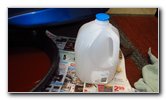 Empty Gallon Water Jug |
| Spin in the drain
plug and tighten it in the clockwise direction until it is snug. Try to avoid over tightening the plug to prevent from cracking the plastic or damaging the rubber o-ring. The old coolant in our 2010 Corolla looked really good after 95,000 miles. The most important reason for performing a drain and re-fill during the 100K mile service is to renew the corrosion inhibitors in the coolant. Since the coolant becomes more acidic over time and the rust inhibiting additives lose their effectiveness, replacing most of the old coolant can help protect the water pump, radiator, thermostat, radiator cap from corroding (rusting). If your old coolant is full of debris or looks cloudy, have the system serviced by a professional. The cooling system might need to be thoroughly flushed out or their might be oil leaking into the coolant. To measure how much old coolant you drained out, use an empty gallon water or milk jug. |
||
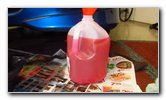 Fluid From Radiator |
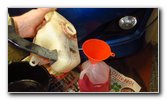 Empty Overflow Bottle |
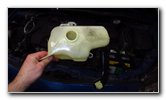 Flush Out & Clean |
| Slowly pour the old
coolant from the catch basin into the gallon jug. Since I spilled a small amount of coolant on to the newspapers and cardboard box I placed below the engine bay, I estimate that I drained about 3.75 to 4 quarts of old coolant. The gallon bottle only filled up to just over 3 quarts when I emptied the catch basin. When I poured the old coolant from the reservoir bottle into the gallon jug, it reached to the very top. Use a garden hose to flush out any debris or trace amounts of old coolant from the overflow / expansion bottle. Shake out all of the tap water from the bottle before re-installing it. |
||
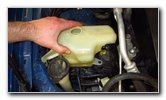 Lower In Plastic Bottle |
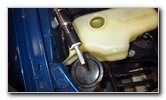 Bolt Taped To Socket |
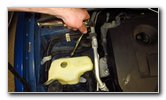 Tighten Clockwise |
| Lower the coolant
overflow bottle down into the engine bay. I chose to loosely attach the bolts to my socket with some electrical tape to prevent them from falling down into the engine bay. |
||
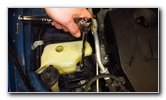 Replace Front Right Bolt |
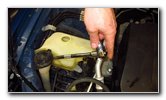 Tighten Front Left Bolt |
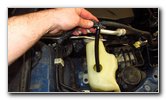 Lower In Suction Hose |
| Tighten the three
bolts by turning them in the clockwise direction until they are snug. Try to avoid over tightening the bolts to prevent from cracking the plastic mounting brackets. Lower the coolant recovery vacuum hose into the bottle and snap the cap into place. |
||
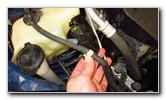 Pop Tube Into Clip |
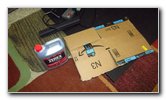 Zerex Asian Coolant |
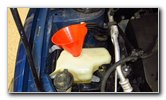 Clean Automotive Funnel |
| Push the rubber
hose into the white plastic clip attached to the metal bracket. As I mentioned before, I had a new 1 gallon bottle of Zerex Asian Vehicle Coolant and also about another quart of Zerex coolant in an old bottle from a previous drain and refill procedure done on another car. Lower a clean and small automotive funnel into the reservoir bottle. |
||
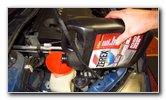 Fill Overflow Bottle |
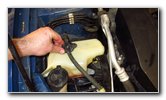 Replace Hose & Cap |
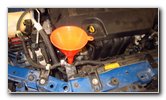 Funnel - Radiator Fill Hole |
| Pour in some new
coolant until the level reaches about half way between the "L" (LOW) and "F"
(FULL) lines on the side of the bottle. Do not fill the bottle all the way up to "FULL" to allow some space for expansion when the coolant and engine are hot. Replace the hose and plastic cap. Move the plastic funnel to the fill hole in the top left of the radiator. Slowly pour in new coolant until the level reaches the top of the radiator filler neck. (Note - In Canada, the Toyota SLLC sold at dealerships has a ratio of 55% coolant and 45% deionized water with a minimum operating temperature specification of -44 degrees Fahrenheit / -42 degrees Celsius. The higher coolant / antifreeze content is to help prevent freezing in the colder Canadian climates.) |
||
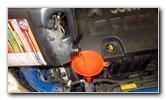 Pour In New Coolant |
 Start 1.8L I4 Engine |
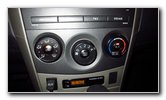 Turn On Heat - Max Fan |
| Remove the funnel
and leave the radiator cap off. Start the engine, move the A/C temperature control to the hottest setting and rotate the blower fan knob to the maximum setting of "4". |
||
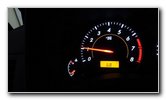 Engine Warming Up |
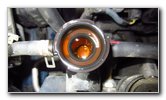 Coolant Level Dropping |
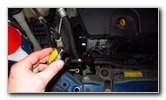 Fill Coolant To Top |
| As the engine warms
up, some of the air in the cooling system will bleed out of the radiator
fill hole. You may notice bubbles escaping from the radiator filler neck. Very carefully and slowly pour in more new coolant as the level in the radiator filler neck drops down out of sight. Once the level stops dropping after a few minutes, turn off the ignition. Don't let the engine run for any longer than necessary to bleed air out of the system. There is a small chance that the coolant will expand and start spilling out of the radiator filler neck. |
||
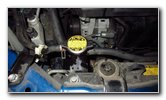 Twist On New Cap |
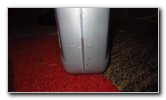 Small Amount of Coolant |
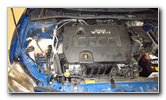 Coolant Change Complete! |
| Twist on the
radiator cap in the clockwise direction. I still had a small amount of new coolant left in the bottle. Take the car for a short test drive and keep an eye on the temperature gauge. If you see the needle quickly moving up from "C" (Cold) towards "H" (Hot), turn the heat on full blast and head back to your home. Once the engine is COLD, check the coolant level in the radiator and top it off if necessary. You may not need to pour in the entire gallon of new coolant for the level in the radiator to reach the filler neck depending on how long you drained out the old coolant. Be sure to check your driveway, parking spot or garage floor for drops of coolant which might indicate a leak from the drain plug or the radiator cap. During the next few days, be more aware of the movements of the needle on the temperature gauge when you are driving especially when in stop-and-go traffic or on the highway. The temperature gauge needle should consistently remain somewhere in the middle of the range between "C" and "F" as you are driving. I would also recommend that you double check the level in the radiator first thing in the morning when the engine is cold and top it off with additional coolant if necessary. Don't forget to write down the coolant change in your vehicle's service records. The service interval specification in the owner's manual for changing the coolant is 100,000 miles. If you live in an extremely hot climate, drive for a ride-sharing service such as Uber or Lyft or you tow with your Corolla, it would be wise to change your coolant more frequently such as every 60,000 or even every 30,000 miles. Please be sure to clean up any spilled coolant since it tastes sweet and is toxic to both animals and children. Take the old coolant to your local hazardous waste collection center to be recycled or bring it to an auto parts store, a mechanic's service station or your dealership. For more, check out my other Corolla DIY tutorials at the links below - 2009-2013 Toyota Corolla Repair & Maintenance Guides |
||
| If you found this guide to be helpful,
please consider making a small donation by clicking on the PayPal.com
"Donate" button located to the right of this paragraph. Thank you!
(Note: I am not a registered charity. Donations are not tax deductible.) |

